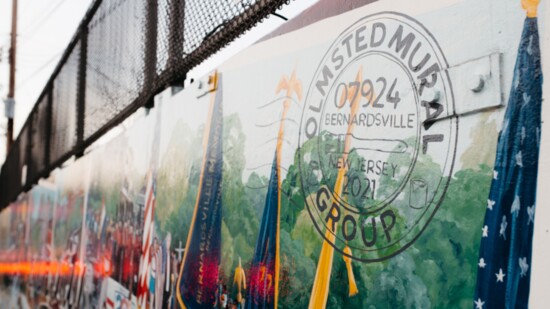This year is a monumental one in Bernardsville as it celebrates its historic separation from Bernards Township, setting it on a journey to write its own story.
The chapters of this book start when the tiny town was simply called “Vealtown.” It is said that Vealtown was settled in 1736. Vealtown and Baskenridge became two of the four main sections of Bernards Township, which was named in 1760 in honor of Sir Francis Bernard, the then–Royal Governor of New Jersey.
Cattle driven from Mendham to Perth Amboy were stopped in Vealtown for watering, and a 1700s slaughterhouse in Vealtown was supposedly near Depot Place.
Vealtown’s notoriety came to the forefront on December 12, 1776, the night before General Charles Lee left his soldiers at Vealtown’s John Parker Tavern and rode to Basking Ridge’s “Widow White’s Tavern.” The next morning, the colonies changed forever as General Lee’s capture by the British secured General Washington’s position to lead the Continental Army.
Bernardsville’s Watchung Mountain—referred to as the “Blue Hills” by soldiers and generals during the Revolutionary War—served as a coveted ore repository, with ore being dug from the mountain mines along the Mine Mount River. These mines would support the freedom cause.
In 1840, the residents of Vealtown changed the name to Bernardsville. In the spring of 1849, Bishop Edmund Janes, a mining prospector and a Methodist Bishop, settled his family for the summer at the top Bernardsville’s Mine Mountain to capitalize on the air of this hilly region, which was favorable to the health of his wife and children.
In the 1870s, visits to the Somerset Hills were on the rise, facilitated by the railroad that reached Bernardsville. With Essex County growing too crowded, the masses flocked to Morristown and the surrounding area. Bernardsville’s Old Stone Hotel, the Bernards Inn and the Claremont Hotel were opened, but nothing would match the exclusive Somerset Inn at the top of the Bernardsville Mountain.
Bishop Janes’ Mount Wesley home was acquired in 1870 by Francis Oliver, who turned the home into a summer bed-and-breakfast and introduced the area to two guests: influential banker George Seney and world-renowned architect George B. Post. Seney loved the area so much that he acquired Oliver’s boarding house and in 1877 expanded the area into what became the Somerset Inn, one of New York City’s most famous summer escapes.
Imagine this five-story, 500-guest hotel providing grand views from the mountain’s highest elevation. It boasted some of the most luxurious amenities in the region: grand ballroom, dining halls, parlors, billiards, cafe, barber shop, newsstand, outdoor swimming pool, tennis courts, equestrian activities, fox hunting, golf course (Somerset Hills Country Club), walking paths, gardens, post office and a telegraph office. Kitchen chefs used the vegetables from the large vegetable gardens off Washington Road for “farm-to-table” dishes.
Then on May 6, 1908, in the middle of the night, a fire of unknown origin reduced the Somerset Inn to 20 chimneys just weeks before the June 1 season opening.
From the late 1800s to the 1930s, the Gilded Age was the grandest time on Bernardsville Mountain. Large chunks of property were sold to wealthy New Yorkers looking for a summer retreat with cool mountain breezes. The Passaic Valley and Peapack Railroad formed the “Millionaire’s Express,” catering to those traveling from Hoboken and often leading to local carriage traffic jams bringing residents to their estates.
As the wealthy started to take up full-time residence on the mountain, recreation became a focal point. In 1890, Charles Pfizer, son of the Pfizer pharmaceutical company founder, purchased the Essex Hunt Club from West Orange and relocated it to the Bernardsville mountain in 1892, coincidently to a Seney home called “The Maples.” Pfizer would later move the Hunt Club to Peapack where it still exists today. Pfizer’s corporate home was also in the area for over a century.
In 1924, Bernardsville residents became restless about how nearby Bernards Township was spending their tax dollars. After a first vote failed, a second vote was made and Bernardsville was separated from Bernards on April 24, 1924, by an act of the State Legislature.
Today, Bernardsville is a bustling town with nicknamed sections, such as “The Mountain Colony,” “The Downtown Area” and “Little Paraguay,” an area that previously had been coined “Little Italy” after the residents who were employed by those on the mountain.
Today, near the town’s railroad station stands a life-sized bronze statue honoring a local icon: Millicent Fenwick, who was 64 when she took her seat in the 94th Congress in 1975. After her death in 1992, resident, resident Christa O’Connor started a campaign in the local newspaper, which resulted in the statue depicting Fenwick opening her arms to embrace the town, her iconic pipe in her pocket. Sculpted by Dana Toomey, a former resident of Bernardsville who then lived in Italy, statue was dedicated on October 15, 1995, and was first outdoor sculpture depicting a female in the state.
Enjoy Bernardsville’s history all year long with a variety of town events celebrating the centennial.
Happy Birthday, B’ville! You’ve earned it.
Brooks Betz is the founder and trustee of The Mr. Local History Project, a 501(c)(3) nonprofit dedicated to preserving and promoting New Jersey history with a social twist. Visit MrLocalHistory.org to learn more.
The Gilded Age was the grandest time on Bernardsville Mountain.
Bernardsville is a bustling town with nicknamed sections.
